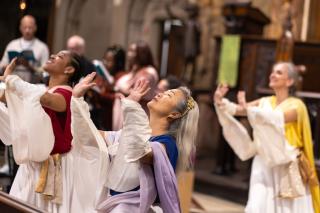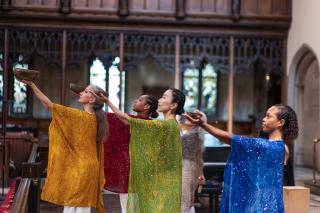Advertisement
Under the soaring ceiling of a landmark neo-Gothic building in midtown Manhattan and silhouetted against an ornate marble altar, five women in flowing white pants and colorful shimmering tunics dance and swirl. Each strikes a Tibetan singing bowl she holds, then as the sound reverberates through the enormous space, they hold their bowls aloft with graceful movement.
It is October 22, 2023, “Power Sunday” for a group of Unitarian Universalist congregations across the country, a special service calling on UUs to become active parts of civil society and uphold non-governmental institutions. At the Community Church of New York UU, the Omega Dance Company, one of the oldest sacred dance companies in the country, is leading congregants into meditation.
Just before Rev. Peggy Clarke’s sermon, the troupe dances again, to an audio recording of poet and activist Amanda Gorman reading “The Hill We Climb,” the poem she wrote for the inauguration of President Joe Biden. As Gorman’s voice rings through the church, the dancers begin their own poetry in motion—connecting hands, releasing them for solo movements, grasping each other’s shoulders, and moving in a circle. When the performance ends, the congregation bursts into applause; some leap to their feet for a standing ovation.
This is dance liturgy, a monthly feature at Community Church since December 2022, when Clarke, eager for new forms of spiritual engagement for her congregation, invited the Omega dancers to be a regular part of worship.
This is dance liturgy, a monthly feature at Community Church since December 2022, when Clarke, eager for new forms of spiritual engagement for her congregation, invited the Omega dancers to be a regular part of worship. Shared ministry is a feature of Community Church, and adding sacred dancers to services enriches the congregation’s common experience, Clarke believes.
For nearly 200 years, Community Church has served as a center of liberal religious community and freedom of expression in the heart of Manhattan. A multiracial, multicultural, multigenerational congregation deeply embedded in the local community, it has two primary spiritual paths, according to Clarke: justice, a focus shared by many UU congregations; and art.
Music is, of course, a key part of worship at most, if not all, UU congregations, including this one, and the congregation has both a musician-in-residence, Darnell White, and a director of music, Gerald A. Brown. But befitting a congregation in the heart of one of the world’s most vibrant artistic centers, Community Church’s embrace of art as spirituality extends into a variety of media.
Many church members are deeply involved in artistic endeavors, professionally or for fun: there are fiber artists, composers, musicians, stained glass artists, professional singers, and more. And for years, the church has been home to an art gallery, Gallery35 at Community, which is currently online-only until the congregation purchases a new building.
“The idea that art is a spiritual path is strong here, really strong,” Clarke emphasizes. “Art is a heart-centered way we find meaning and ask big questions. Dance is the embodiment of meaning-making and living deeply.”
Bringing Liturgical Dance to Community Church
To create connection and community, Community Church of New York UU partnered with the Omega Dance Company. See how that’s deepened spiritual engagement.
She first explored the idea of dance in 2019, shortly after she was called as Community Church’s senior minister.
At that time, she reached out to the Omega Dance Company in Manhattan, which she had seen perform in other settings. But the plans were put on hold when the COVID-19 pandemic hit in 2020.
When the church reopened in person in 2022, it was busy selling several buildings it had long owned in Manhattan, then moving into temporary space at the Church of the Incarnation, an Episcopal church whose building is on the National Register of Historic Places.
The new quarters spurred Clarke to reopen her hopes for dance liturgy. While Clarke says the building “is gorgeous, it’s on every historical list, it’s enormous and very long and very traditional Episcopalian,” she also notes that “you can get three hundred people in here and it still feels empty. So, I went back to the idea of bringing dance in to create the energy we need to fill the space.”
Clarke reached out again to Omega, whose tagline is, “Revealing the sacred through movement.” The troupe, composed of professional dancers, has offered dance liturgy with different kinds of faith communities, including All Souls NYC UU. Depending on the intention for a particular service, the number of dancers can vary. At Power Sunday, the five dancers were Maura Burns, Martha Chapman, Vanity David, Maki Kitahara, and Aliyah Miller.
Photo Gallery (For full captions, view on Flickr.)
“Reverend Peggy wanted to find ways to physically ground and draw the community into being together in the flesh, and she thought having dancers present and having movement that was done by professionals would help strengthen that physical energy and connection,” explains Chapman, Omega’s co-director, who was a professional ballet dancer.
She and Clarke decided that Chapman would dance solo at the congregation’s annual “Art Sunday” service and see how the congregation reacted, since some church members were dubious.
“Dance-skeptic” is how Jonathan Birchall, an eighteen-year member and president of the board of trustees, described himself. It would be “very easy to just be awkward and not to have any kind of transcendent aesthetic,” says Birchall. But after watching Chapman dance, he says, “I’m a convert.”
He also appreciates that the dancers lead the congregation in hand and arm movement during the chalice lighting.
In the monthly dance liturgy, the Omega dancers add “to the emotional intensity of the service,” he says, both during contemplative moments, when they often dance with Tibetan singing bowls, and during more active points when they may use banners and rapid movements. Then the service “becomes exuberant. It exudes energy into the experience of worship, which I think is galvanizing and inspiring—so I’m sold!”
‘Living More Deeply Together in Community’

Before the congregation saw Chapman in action, “I knew they weren’t overly enthusiastic,” says Clarke, “but I also knew they couldn’t imagine it, that they would just have to see it. When they did, they loved it.”
Now the troupe typically performs at several points: during the chalice lighting, when they lead congregants through simple hand gestures; during meditation; during a hymn or other moment of reflection, such as Gorman’s poem; and when they lead the congregants out during the recessional.
“Art is part of this congregation’s spiritual practice,” says Clarke, “and bringing in dance has deepened that practice.”
Last year’s budget for the dancers was $12,000, which the congregation increased this year to $17,000 because “people really do love it” and because they agree that professional dancers, like everyone else, should be paid for their work, Clarke says. When Community Church eventually buys a new building, they are hoping to build a dance studio and create space for a dancer in residence.
Community Church isn’t the only UU congregation with a dance liturgy. For almost thirty years, the Chalice Dancers, who come from different dance traditions and have different abilities, have brought sacred movement into worship at Paint Branch UU Church in Hyattsville, Maryland, and have performed at other nearby UU congregations and for other faith traditions. (Their sixteenth annual dance service, Resistance, Resilience, and Renewal, is a part of the UUA on-demand library of virtual services from General Assembly 2021.)
And while it’s true that Community Church has more funds and access to professional dancers than less-urban congregations, Clarke believes most congregations could incorporate dance liturgy in one way or another. “You could partner with a small dance company or a local university or high school,” she says. If there’s no budget for dancers, she suggests a congregation could barter in exchange for rehearsal space or living quarters, if the congregation has those.
“This isn’t performance, it’s not something you watch someone else do, it’s weaving art into the service.”
But it’s essential to find dancers who understand liturgical dance or are willing to learn, she advises.
“This isn’t performance, it’s not something you watch someone else do, it’s weaving art into the service,” Clarke says. “It’s a time to embody the ritual, the spiritual path you are sharing together.
“I started this as an experiment because I think we all need more beauty and more joy and more ways of expressing ourselves and living more deeply together in community,” she continues. “I’m not saying dance is our salvation, I’m saying we need to be experimenting with a wide variety of ways to meet very real needs.”
